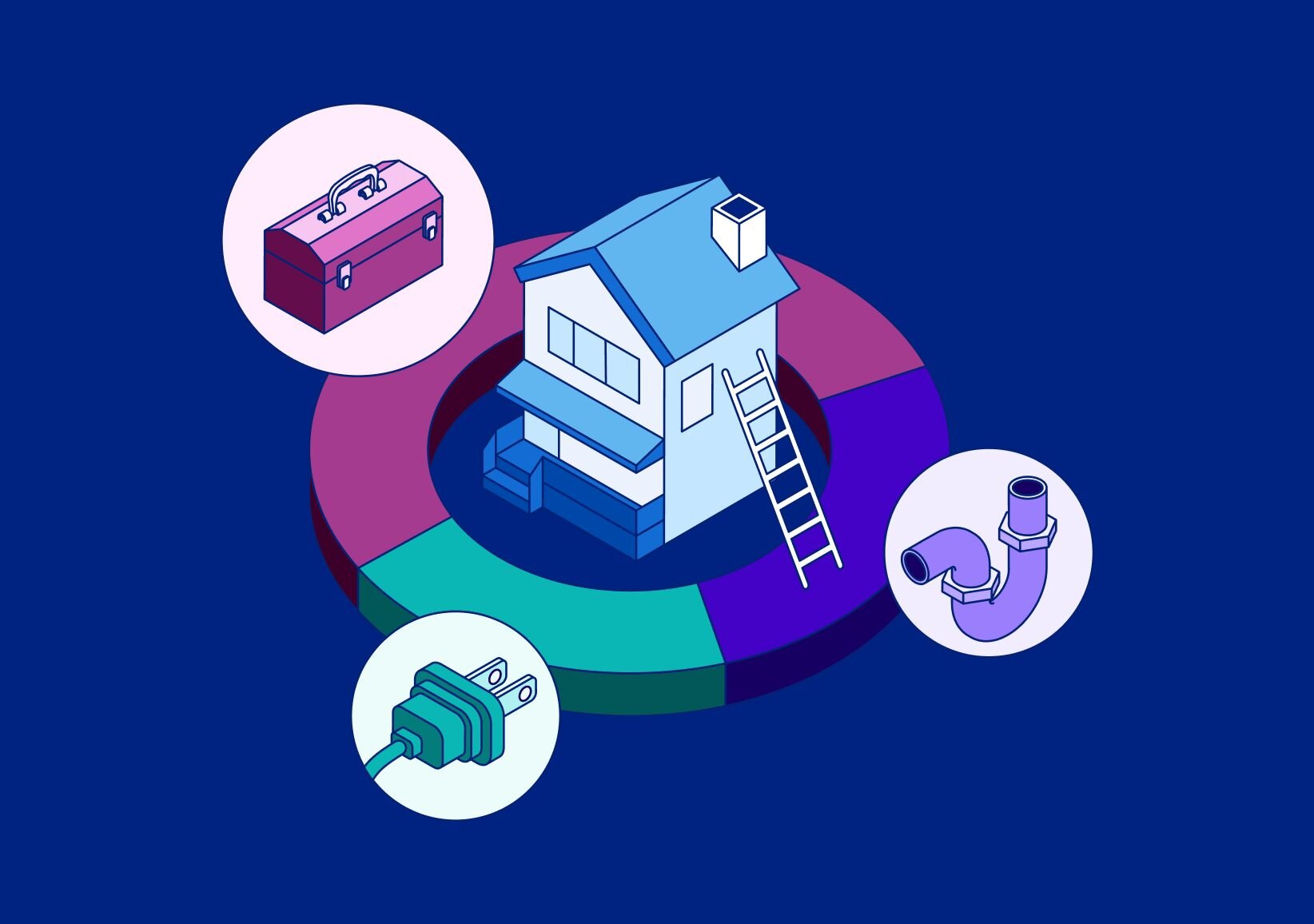In the competitive home services space, staying ahead means keeping a keen eye on the numbers that matter. As 2025 unfolds, there are critical statistics that every home services professional should be aware of. These figures not only shed light on current trends and consumer behaviors but also serve as pivotal guides in crafting a marketing strategy that's both effective and responsive to the evolving market demands.
Stats about the home services market
1. The home services market is valued at $485 billion and growing.
There is plenty of money to be made by home services companies that understand their prospective customers. Strategic home services marketers can take advantage of the demand for these services by identifying who their ideal customers are, reaching these prospects with marketing that addresses their challenges, and tracking the ROI of their campaigns.
2. 48 million US homeowners now have a record $11 trillion in tappable home equity.
Homeowners are now able to leverage more home equity than ever for various purposes such as home renovations, debt consolidation, or investment opportunities. The significant increase in home values has contributed to this milestone, offering homeowners the potential to access this equity for financial flexibility and wealth-building strategies. It also reflects a trend of growing wealth through homeownership, highlighting the financial stability and opportunities available to a large segment of the population.
Stats about investing in reviews and testimonials
3. 91% of consumers say local branch reviews impact their overall perceptions of big brands in some way.
Local branch reviews wield considerable influence over consumer perceptions of major brands, shaping opinions and attitudes in various ways. These reviews serve as a window into the customer experience, impacting how real customers view the overarching brand identity and reputation. Understanding this is vital if you have a multi-location business.
4. 88% of consumers would use a business that replies to all of its reviews, compared to just 47% who would use a business that doesn’t respond to reviews at all.
Local branch reviews wield considerable influence over consumer perceptions of major brands, shaping opinions and attitudes in various ways. These reviews serve as a window into the customer experience, impacting how real customers view the overarching brand identity and reputation. Understanding this is vital if you have a multi-location business.
5. 81% of consumers rely on Google Reviews to determine whether or not to use a business
Google Reviews hold significant sway over consumer choices when it comes to selecting businesses. This is why it is crucial to encourage your current clientele to leave a review based on their experience. With a vast array of reviews readily accessible on Google, consumers rely on this platform to gauge the trustworthiness, reliability, and overall reputation of businesses before making purchasing decisions.
6. 58% of consumers preferred the AI-written review response when shown one written by a human and one generated with AI.
Like many other industries, home service businesses can benefit from using AI to better the customer experience and increase operational efficiency. A growing number of consumers exhibit a preference for AI-generated review responses over those crafted by humans in certain scenarios. AI technology offers efficiency, consistency, and personalization, resonating with consumers seeking timely and relevant feedback from businesses.
7. 34% of consumers use Instagram, and 23% use TikTok as alternative local business review platforms.
Social media platforms such as Instagram and TikTok are increasingly becoming alternative hubs for local business reviews. With visually engaging content formats and a thriving community of users, these platforms provide consumers with additional avenues to discover, share, and evaluate experiences with businesses.
8. 77% of consumers use two or more review sites when deciding to use local businesses.
Consumer behavior reflects a diverse approach to accessing information about local businesses, with many individuals consulting multiple review sites before making decisions. 36% of consumers use two review sites, while 41% use three or more to decide to use a business. By leveraging insights from various platforms, consumers ensure thorough research and informed choices when selecting businesses to engage with.
Stats about home services consumer internet practices
9. 98% of consumers use the internet to find information about local businesses.
Since so many people search online for local businesses before setting an appointment, home services marketers need to make sure prospective customers can find their company online. That means keeping the website updated with information about services, hours, and contact details. Also, the Google Business Profile and social media channels should be active, and the business should respond to comments and reviews.

10. On average, over 55% of consumers run a search before scheduling an appointment with a home services business.
This statistic highlights the trend of consumers using digital platforms for home improvement and maintenance decisions. Consumers search for service provider info, reviews, pricing, and availability to make informed choices. Home services businesses need a strong online presence, visibility in search results, and positive reviews to engage effectively with potential customers.
11. The average click-through rate (CTR) for home services search ads is 4.80%.
Some home services specialties see a slightly higher than average CTR like construction & general contractors (6.25%) and pest & rodent control (5.54%) and some see a slightly lower CTR like plumbing (3.34%) and HVAC installation/repair (3.40%). In the competitive home services market, the top businesses use a marketing softwareplatform like CallRail to show them which ads work best so they can easily turn more leads into booked jobs – before they head to the competition.
12. The average cost per click (CPC) for home services search ads is $6.55.
Pools & Spas as well as Construction & Contractors both had the lowest average cost per click at $3.60. The home services businesses with the highest average cost per click are Roofing & Gutters ($11.13), HVAC Installation & Repair ($9.49), Pest & Rodent Control and Plumbing ($9.39).
These variations in CPC rates reflect the competitive landscape and consumer demand dynamics within different segments of the home services industry.
13. The average conversion rate for home services search ads is 10.22%.
The home services businesses with the highest conversion rates were Plumbing (15.61%), Pest & Rodent Control (15.52%), and HVAC Sales (15.11%). Meanwhile, Construction & Contractors had the lowest conversion rate (3.65%), along with Roofing & Gutters (5.58%), and Pools & Spas (11.81%).
These stats highlight the varying degrees of effectiveness in converting ad clicks into tangible business outcomes across different sectors within the home services industry. Understanding these conversion dynamics can inform businesses' efforts to enhance their advertising performance and maximize return on their marketing investment.
14. The average cost per lead for home services search ads is $66.02.
Some home services had lower-end average costs per lead, like Pools & Spas ($29.08), Pest & Rodent Control ($45.60), and Landscaping ($64.72).
On the other hand, Roofing & Gutters had the highest average cost per lead ($186.79) for the home services businesses we analyzed. Construction & Contractors had the second highest average cost per lead ($93.69) and HVAC took the third-highest average cost per lead spot ($92.76).
Stats about phone call usage for home services companies
15. Calls are still the #1 choice for consumer communications
Calls are viewed as the safest way to communicate, especially with personal information like home address and payment details. Home services companies need to make sure they answer every call — and provide top-notch service, accurate quotes, and follow-up in a timely manner. CallRail helps home service pros drive more calls to their business and treat every caller like they’re the only one.

16. 34% of home service customers prefer phone calls as their primary method of communication with home service providers
This preference is followed by email at 24% and text at 14%. It showcases the consumers continued desire for personalized, direct interaction when addressing inquiries, scheduling appointments, and discussing service details within the home services industry.
17. Working professionals report that 38% of phone calls are used for resolving issues and 29% are used for closing sales
Communication in addressing customer concerns, providing timely support, and fostering meaningful interactions is multifaceted. Imagine missing out on 29% of sales because your business is missing calls or investing in different avenues of communication instead. Even now, customers prefer calling for some of their most important interactions with home service providers.
18. 38% of workers report that their business has been financially impacted by an inability to reach prospects and/or customers
This statistic highlights the tangible economic consequences of communication barriers, underscoring the critical importance of efficient communication channels in sustaining business growth and profitability. Much of the financial impact stems from simply missing out on leads or sales opportunities simply because of miscommunication. With so many tools available to make customer communication easier, there’s no reason to miss out on these opportunities in this year.
19. 42% of workers say they have lost customers or a potential deal because of the inability to connect by phone
There can be detrimental effects on customer relationships and revenue generation due to communication breakdown. Businesses should be prioritizing effective communication strategies to mitigate such losses.
20. 50% of business professionals have increased their phone call usage in the last 12 months
There is a growing reliance on voice communication as a primary mode of interaction in business settings, even when there are now so many other options available. Driven by evolving market dynamics and changing communication preferences among professionals, phone calls remain king with homeowners.
21. 1 in 3 businesses have had their name used by an impersonator making scam calls
A more recent issue in the customer communication space is scam calls. It’s become more crucial now than ever to have robust security measures to safeguard business reputation and consumer trust. Having a call attribution model implemented in your marketing strategy can help ensure that your brand identity is attached to every call, giving customers peace of mind.
22. 87% of consumers believe unidentified calls may be fraudulent
An overwhelming majority of consumers harbor suspicions towards unidentified calls, viewing them as potential sources of fraudulent activity. This perception reflects growing concerns surrounding phone-based scams and underscores the importance of transparency in caller identification to alleviate consumer apprehensions and foster trust.
23. 72% of consumers say they’re more likely to answer a call if they know who’s calling
In order to have a great phone interaction or close a sale over the phone, the customer first needs to pick up the call. Over half of consumers won’t even answer a call if they don’t know who it is. This is why ensuring your company name shows up on customers’ caller ID is an integral part of your calling strategy. Not only does it give your business a verified authority, but it increases the chances of current and potential customers actually picking up your calls in the first place.
Stats about Call Tracking and Conversation Intelligence®
24. Home services businesses that use a Call Tracking solution reduce cost per lead by 10%
By knowing for sure how effective your different marketing channels and campaigns are in getting your leads to call your home services business, you can better allocate resources, optimize your marketing spend, and ultimately improve your ROI..
25. The use of Conversation Intelligence decreases time spent qualifying leads by 50%
Leveraging Conversation Intelligence tools has proven to be highly effective in streamlining lead qualification processes. By automatically transcribing and analyzing calls, businesses can swiftly identify promising leads and focus their efforts on prospects with the highest likelihood of conversion, optimizing operational efficiency and maximizing sales productivity.
26. Those who use Conversation Intelligence in their call tracking efforts spend 60% less time reviewing and analyzing calls
Conversation Intelligence enables home service pros to efficiently extract valuable insights and sentiments from call data, empowering sales and marketing teams to make data-driven decisions and implement targeted strategies with greater agility and precision. The best part? The analysis is done for you and then summarized into an actionable report, so you spend less time listening back to calls and more time locking in those leads.
27. Customers using Conversation Intelligence and Call Tracking together saw a 20% reduction in cost-per-lead
By leveraging these call tracking solutions, businesses can optimize lead generation efforts, enhance lead quality, and minimize acquisition costs, thereby achieving greater ROI and maximizing profitability. When you have all the data in front of you, it’s easier and faster to optimize your budget to invest in what campaigns are truly working.
28. The use of Call Tracking and Conversation Intelligence led to a 7% increase in call lead-to-close rates per customer interviewed
Businesses employing Call Tracking and Conversation Intelligence in tandem witness tangible improvements in call lead-to-close rates. Gaining deeper insights into customer interactions, identifying key conversion drivers, and tailoring sales approaches accordingly will drive higher conversion rates and bolster overall sales performance.
What does all this mean for home services marketers?
The data provides insights for home services marketers, highlighting trends and consumer behaviors. The market's size and growth offer opportunities for companies to understand their audience. With more remodeling and repairs due to pandemic lifestyle changes, marketers can benefit by tackling consumer challenges and boosting online visibility.
Consumer reliance on online reviews, especially Google Reviews, emphasizes the need for active online presence and feedback engagement. AI-generated responses to reviews are also gaining acceptance. Diversification of review platforms to include social media expands marketers' possibilities for reaching out to their audience.
Understanding consumer communication preferences, like phone calls, stresses efficient communication channels. Home service businesses using call tracking and conversation intelligence enhance lead qualification and increase call lead-to-close rates. The data shows that tailored marketing, online engagement, and effective communication are key in the competitive home services market.
Ready to elevate your marketing strategy and unlock deeper customer insights?
Try CallRail’s Call Tracking and Conversation Intelligence® today! Streamline your marketing efforts, engage with customers more effectively, and maximize your ROI with CallRail.
Try CallRail for free for 14 days!












